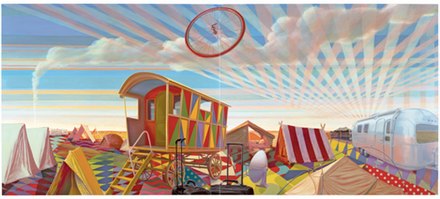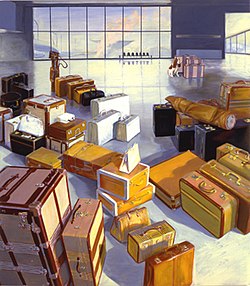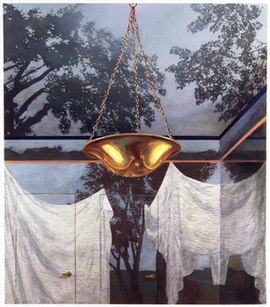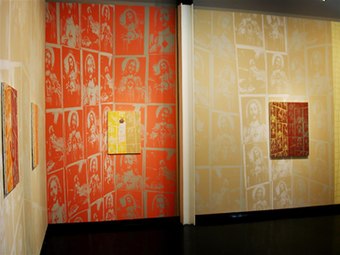
The Solomon R. Guggenheim Museum, often referred to as The Guggenheim, is an art museum at 1071 Fifth Avenue between 88th and 89th Streets on the Upper East Side of Manhattan in New York City. It is the permanent home of a continuously expanding collection of Impressionist, Post-Impressionist, early Modern, and contemporary art and also features special exhibitions throughout the year. It was established by the Solomon R. Guggenheim Foundation in 1939 as the Museum of Non-Objective Painting, under the guidance of its first director, Hilla von Rebay. The museum adopted its current name in 1952, three years after the death of its founder Solomon R. Guggenheim.

Wallpaper is a material used in interior decoration to cover the interior walls of domestic and public buildings. It is usually sold in rolls and is applied onto a wall using wallpaper paste. Wallpapers can come plain as "lining paper", textured, with a regular repeating pattern design, or, much less commonly today, with a single non-repeating large design carried over a set of sheets. The smallest rectangle that can be tiled to form the whole pattern is known as the pattern repeat.

Milton Ernest "Robert" Rauschenberg was an American painter and graphic artist whose early works anticipated the Pop art movement. Rauschenberg is well known for his Combines (1954–1964), a group of artworks which incorporated everyday objects as art materials and which blurred the distinctions between painting and sculpture. Rauschenberg was both a painter and a sculptor, but he also worked with photography, printmaking, papermaking and performance.

Jean-Édouard Vuillard was a French painter, decorative artist, and printmaker. From 1891 through 1900, Vuillard was a prominent member of the avant garde artistic group Les Nabis, creating paintings that assembled areas of pure color. His interior scenes, influenced by Japanese prints, explored the spatial effects of flattened planes of color, pattern, and form. As a decorative artist, Vuillard painted theater sets, panels for interior decoration, and designed plates and stained glass. After 1900, when the Nabis broke up, Vuillard adopted a more realistic style, approaching landscapes and interiors with greater detail and vivid colors. In the 1920s and 1930s, he painted portraits of prominent figures in French industry and the arts in their familiar settings.

Adolph Gottlieb was an American abstract expressionist painter, sculptor and printmaker.
Philip Martin Pearlstein was an American painter best known for Modernist Realist nudes. Cited by critics as the preeminent figure painter of the 1960s to 2000s, he led a revival in realist art.
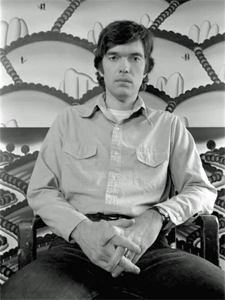
Roger Brown was an American artist and painter. Often associated with the Chicago Imagist groups, he was internationally known for his distinctive painting style and shrewd social commentaries on politics, religion, and art.
Rackstraw Downes is a British-born realist painter and author. His oil paintings are notable for their meticulous detail accumulated during months of plein-air sessions, depictions of industry and the environment, and elongated compositions with complex perspective.

Kenzo Okada was a Japanese-born American painter and the first Japanese-American artist working in the Abstract Expressionist style to receive international acclaim. At the 29th Venice Biennale in 1958, Okada’s work was exhibited in the Japan Pavilion and he won the Astorre Meyer Prize and UNESCO Prize.

Paul Feeley was an artist and director of the Art Department at Bennington College during the 1950s and early 1960s.

Abby Leigh is an American artist based in New York City. Her work is held in public collections including the Museum of Modern Art, New York, NY; the Whitney Museum of American Art, New York, NY; the Guggenheim Museum, New York, NY; the Metropolitan Museum of Art, New York, NY; The Hammer Museum, Los Angeles, CA; Houston Museum of Fine Arts, Houston, TX; among others.
Pattern and Decoration was a United States art movement from the mid-1970s to the early 1980s. The movement has sometimes been referred to as "P&D" or as The New Decorativeness. The movement was championed by the gallery owner Holly Solomon. The movement was the subject of a retrospective exhibition at the Hudson River Museum in 2008.
Dike Blair is a New York-based artist, writer and teacher. His art consists of two parallel bodies of work: intimate, photorealistic paintings and installation-like sculptures assembled from common objects—often exhibited together—which examine overlooked and unexceptional phenomena of daily existence in both a romantic and ironic manner. Blair emerged out of the late 1970s New York art scene, and his work relates to concurrent movements such as the Pictures Generation, Minimalism and conceptual art, while remaining distinct from and tangential to them. New York Times critic Roberta Smith places his sculpture in a "blurred category" crossing "Carl Andre with ikebana, formalist abstraction with sleek anonymous hotel rooms, talk-show sets with home furnishings showrooms." Cameron Martin writes in Artforum that the paintings are "rendered with a lucidity that extracts something metaphysical from the mundane."

Greg Lindquist is an American artist, painter and sculptor based in New York City.

Ellen Harvey is an American-British conceptual artist known for her painting-based practice and site-specific works in installation, video, engraved mirrors, mosaic and glass. She frequently pairs traditional representational vocabularies and genres with seemingly antithetical postmodern strategies, such as institutional critique, appropriation, mapping and pastiche. Her work examines such themes as art as a mirror, interactions between built environment and landscape, ruins and the Picturesque aesthetic, and cultural and economic relationships between museums, artists and publics. Curator Henriette Huldisch writes of her work, "haunted as it is by the notion of art's ultimate futility, her paradoxical stake is in persistently testing art's possibility to do something in the world after all."

JoAnne Carson is an American artist who is known for over-the-top, hybrid works in painting, sculpture and assemblage that freely mix fantasy, illusion and narrative, high and low cultural allusions, and seriocomic intent. She first gained widespread attention in the 1980s for what ARTnews critic Dan Cameron described as "extraordinary painted constructions—kaleidoscopic assemblages chock full of trompe-l’oeil painting, art-history quips, found objects and nostalgic echoes of early modernism." New York Times critic Roberta Smith wrote that Carson's subsequent work progressed methodically into three dimensions, culminating in freestanding botanical sculpture that exuded "giddy beauty" and "unapologetic decorativeness"; her later imaginary landscapes have been described as whimsical spectacles of "Disneyesque horror." Carson has been recognized with a Guggenheim Fellowship, awards from the American Academy of Arts and Letters, American Academy in Rome and National Endowment for the Arts, and Yaddo artist residencies. Her work has been exhibited at institutions including the Whitney Museum of American Art, Museum of Contemporary Art Chicago (MCA), Albright-Knox Gallery, New Orleans Museum of Art, and Institute of Contemporary Art, Philadelphia; it belongs to the public art collections of the Brooklyn Museum of Art, MCA Chicago, Frederick R. Weisman Art Foundation, and Modern Art Museum of Fort Worth, among others.
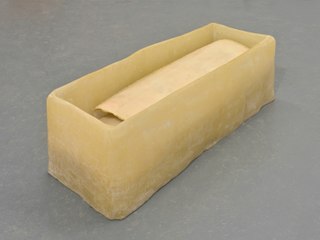
Mia Westerlund Roosen is an American sculptor known for largely abstract, often monumental works that reference the body, eroticism, and primal forms.

Joanna Pousette-Dart is an American abstract artist, based in New York City. She is best known for her distinctive shaped-canvas paintings, which typically consist of two or three stacked, curved-edge planes whose arrangements—from slightly precarious to nested—convey a sense of momentary balance with the potential to rock, tilt or slip. She overlays the planes with meandering, variable arabesque lines that delineate interior shapes and contours, often echoing the curves of the supports. Her work draws on diverse inspirations, including the landscapes of the American Southwest, Islamic, Mozarabic and Catalan art, Chinese landscape painting and calligraphy, and Mayan art, as well as early and mid-20th-century modernism. Critic John Yau writes that her shaped canvasses explore "the meeting place between abstraction and landscape, quietly expanding on the work of predecessors", through a combination of personal geometry and linear structure that creates "a sense of constant and latent movement."

Leigh Behnke is an American painter based in Manhattan in New York City, who is known for multi-panel, representational paintings that investigate perception, experience and interpretation. She gained recognition in the 1980s, during an era of renewed interest in imagery and Contemporary Realism.
Graham Nickson is a British artist known for large-scale figurative paintings and drawings. He was born in Knowle Green, United Kingdom. He has lived in New York City since 1976 and he has been Dean of the New York Studio School since 1988, where he developed a "Drawing Marathon," a two-week program of intensive study. Nickson works in oils, acrylics, charcoal, and watercolor.
